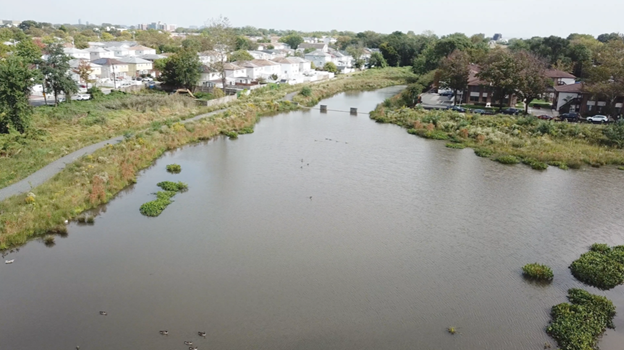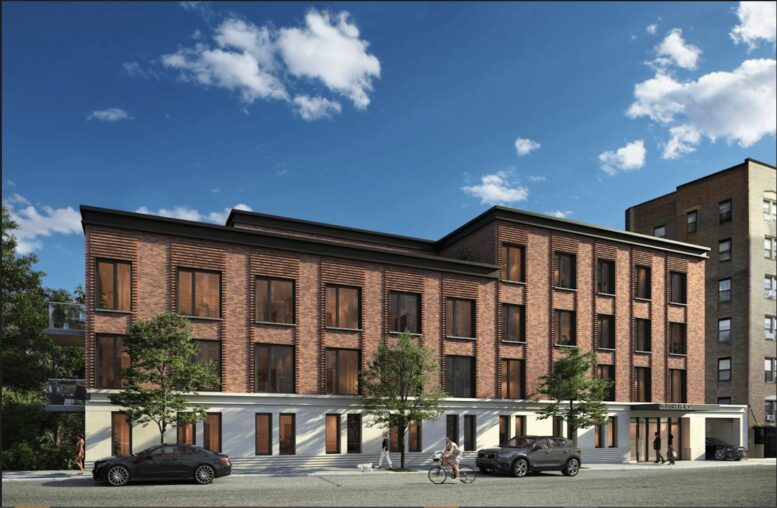Mid-Island’s New Creek Bluebelt Will Reduce Stormwater Flooding and
Fortify Surrounding Communities Against Extreme Weather Due to Climate Change
Marking 11 years since the week Superstorm Sandy — which killed 44 New Yorkers and caused $19 billion in damages and lost economic opportunity to the city — made landfall in the five boroughs, New York City Mayor Eric Adams today announced the completion of a $110 million project to protect the Mid-Island section of Staten Island from flooding, and fortify surrounding communities against climate change-driven extreme weather events by significantly expanding the New Creek Bluebelt. Bluebelts — ecologically rich and cost-effective drainage systems that naturally handle the runoff precipitation that falls on streets and sidewalks — provide both critical support to Staten Island’s drainage infrastructure and beautiful open green space for residents, while creating diverse habitats for wildlife. The New Creek Bluebelt now covers 94 acres and drains a 2,249-acre watershed area.
This portion of the New Creek Bluebelt expansion consists of three connected projects, with construction done in separate phases. With all three phases now complete, stormwater that falls on roadways, rooftops, and sidewalks in portions of the Midland Beach, Grant City, Dongan Hills, and Todt Hill neighborhoods of Staten Island will now drain into new catch basins and storm sewers and be discharged into the New Creek Bluebelt. From there, it will slowly make its way to thelower New York Bay while being naturally filtered along the way.
“Eleven years after Superstorm Sandy stole 44 of our neighbors, family members, and loved ones, the need for major investments in flooding infrastructure has only grown as climate change continues to create stronger storms and extreme weather events. Too often, our concrete jungle gives rain no place to go, leaving communities to manage devastating flooding without the necessary infrastructure. But with this $110 million expansion of the New Creek Bluebelt, Staten Island is more prepared than ever,” said Mayor Adams. “These bluebelts are a key part of our broad strategy to protect New York City from flooding. The days of Staten Island being the ‘forgotten borough’ are over. We will not allow any borough in our city to experience another Superstorm Sandy without being prepared.”
“Today we celebrate how New Yorkers can have it all, a bluebelt that creates open space, greenery, wildlife and critical absorption to protect Staten Islanders against more frequent, heavier and more unpredictable storms,” said Deputy Mayor of Operations Meera Joshi, “Bluebelts are one of many ways the Adams administration maximizes every square foot, turning it into green infrastructure to protect New Yorkers against flooding. We will continue to be creative and opportunistic to build a more resilient city.”
“Bluebelts are a key strategy for managing stormwater throughout the city, making New York more resilient to changing climate. These innovative drainage systems reengineer existing wetlands to protect communities from inland flooding, while also providing beautiful open spaces for residents and wildlife,” said New York City Chief Climate Officer and Department of Environmental Protection (DEP) Commissioner Rohit T. Aggarwala. “As we seek natural solutions to fortify neighborhoods against extreme weather, we need look no further than to the successful development and implementation of the bluebelt program right here on Staten Island.”
“DOT is proud to collaborate with our sister agencies to fight climate change with more resilient, fortified infrastructure. As part of our contribution, DOT worked with our sister agencies to rebuild sidewalks along Hylan Boulevard with upgraded, accessible curbs and curb extensions at intersections to expand pedestrian space and make the corridor safer for all road users,” said New York City Department of Transportation Commissioner Ydanis Rodriguez. “We thank Mayor Adams and the administration for their close partnership.”
“Bluebelts are an efficient and environmentally sensitive way to manage stormwater while preserving open space and beautifying communities,” said New York City Department of Design and Construction Commissioner Thomas Foley. “Congratulations to the DDC team that completed the New Creek Bluebelt. DDC is also building thousands of pieces of green infrastructure around the city, and we look forward to expanding our stormwater management efforts in coordination with the city’s larger flood mitigation strategy.”
“Our wetlands and stream corridors are vital ecological systems that support dragonflies, amphibians, fish, majestic waterbirds, birds of prey, and diverse plant species. As these bluebelt projects demonstrate, our aquatic systems also play a pivotal role in absorbing and managing stormwater and providing critical open space for communities,” said New York City Department of Parks and Recreation Commissioner Sue Donoghue. “We are excited to continue to work with our agency partners to ensure the multiple benefits of these ecosystems are preserved and well managed for New Yorkers.”
“Bluebelts use existing and newly constructed natural resources — streams, ponds, and wetlands — to capture and convey stormwater runoff,” said Mayor’s Office of Climate & Environmental Justice Executive Director Elijah Hutchinson. “They help manage neighborhood flooding, offer critical open space benefits and increase native plantings. The New Creek Bluebelt will be a resilient, restorative destination for Staten Island residents and other New Yorkers alike, and a rich natural environment for social connection and community-building.”

Drone footage of the Staten Island bluebelt network after Tropical Storm Ophelia, September 30, 2023. Credit: DEP
Originally implemented on Staten Island, the bluebelt program preserves natural drainage corridors including streams, ponds, and wetlands, and revitalizes and enhances them to optimize their functions of conveying, storing, and filtering stormwater. Bluebelts have proven to be an excellent mechanism for reducing urban flooding while creating a rich natural environment for the local community. As New York City prepares for rising sea levels and heavier rains due to climate change, bluebelts offer a natural and effective solution for stable and sound stormwater management.
To complete this multiphase expansion of the New Creek Bluebelt, the city most recently concluded a $42 million project in Midland Beach, which encompasses 12 acres and features the largest man-made wetland in the bluebelt system. Enhancements feature two outfalls, stilling basins to reduce water velocity, micropools and forebays to provide maintenance points, and a weir chamber at Olympia Boulevard to regulate the downstream flow of water as it makes its way toward the lower New York Bay. The Midland Beach project also included adding more than 85,400 wildflowers and natural plants, 810 native shrubs, 440 trees, 6,000 linear feet of storm sewers, 2,150 linear feet of sanitary sewers, and 5,300 linear feet of water mains.
Prior to the Midland Beach site, the city undertook the $25 million “Gateway to the Bluebelt,” which created a panoramic-like viewing area introducing the public to the rehabilitated New Creek wetlands. This three-part expansion of the New Creek Bluebelt began with a $43 million project that saw two new wetlands built at Last Chance Pond Park. The Gateway Project, received a $4.9 million grant from the U.S. Department of Housing and Urban Development Community Development Block Grant Disaster Recovery Program. The Last Chance Pond portion of the New Creek Bluebelt received additional funding from an $11 million U.S. Department of Agriculture grant, which was secured by Senator Charles Schumer.
Bluebelts are a key part of the city’s strategy to mitigate inland flooding, while DEP’s new Bureau of Coastal Resiliency focuses on coastal flooding. This holistic approach unifies long-term planning and funding, increases coordination and efficiency, and improves maintenance of flood resilience projects. The Adams administration is also investing billions in grey and green infrastructure to prevent flooding — from neighborhood-scale coastal resiliency projects in Lower Manhattan to porous, receded playgrounds that act as water retention tanks during extreme rainfall, to small rain gardens and other green features that absorb stormwater, among other tools. Additionally, the Adams administration is actively evaluating locations in all five boroughs to expand the successful bluebelt network, including in the Jewel Streets neighborhood between Brooklyn and Queens.
“Recent extreme rain events and flooding are a stark reminder to New Yorkers about the need to adapt our city to the growing impacts of climate change. The expanded New Creek Bluebelt is a terrific example of the kind of infrastructure we need to meet the moment, and be better prepared for the future," said Emily Nobel Maxwell, director, New York Cities, The Nature Conservancy. “The bluebelt helps address local flooding, and benefits wildlife and surrounding neighborhoods. The Nature Conservancy congratulates New York City for completing this important project and encourages ongoing investments in green and nature-based infrastructure to improve quality of life and resilience in New York City.”
“It’s exciting to see the city completing another forward-thinking bluebelt project on Staten Island,” said Cortney Worrall, president and CEO, Waterfront Alliance. “As climate change continues to bring heavy rainfall, often in unexpected ways, bluebelts are a proven way to use nature to help lessen the impacts of climate change, and in this case, manage stormwater. Nature-based solutions like these will make communities and residents less vulnerable to the impacts associated with the climate crisis.”
“New York Restoration Project believes in broadening green infrastructure for all New Yorkers,” said Lynn Bodnar Kelly, executive director, New York Restoration Project.” “Expanding the New Creek Bluebelt on Staten Island is an important step towards making our city more resilient and livable in the face of extreme weather. Bluebelts help modernize and adapt our drainage infrastructure to handle more water while also expanding critical green space.”
“New Yorkers for Parks congratulates Mayor Adams on the forward-looking expansion of the New Creek Bluebelt, which will provide critical support to Staten Island’s drainage infrastructure,” said Adam Ganser, executive director, New Yorkers for Parks. “Our city’s parks and opens spaces are critical green infrastructure, essential in our efforts to mitigate the impacts of climate change. What’s more, this project provides beautiful open green space for Staten Island residents and moves the needle on New Yorkers for Parks’ goals to increase the amount of park space in this densely populated city.”














